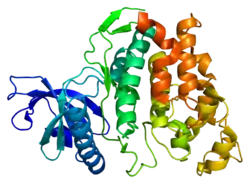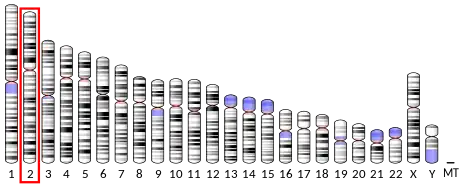CLK1
Dual specificity protein kinase CLK1 is an enzyme that in humans is encoded by the CLK1 gene.[5][6]
| CLK1 | |||||||||||||||||||||||||||||||||||||||||||||||||||
|---|---|---|---|---|---|---|---|---|---|---|---|---|---|---|---|---|---|---|---|---|---|---|---|---|---|---|---|---|---|---|---|---|---|---|---|---|---|---|---|---|---|---|---|---|---|---|---|---|---|---|---|
 | |||||||||||||||||||||||||||||||||||||||||||||||||||
| |||||||||||||||||||||||||||||||||||||||||||||||||||
| Identifiers | |||||||||||||||||||||||||||||||||||||||||||||||||||
| Aliases | CLK1, CLK, CLK/STY, STY, CDC like kinase 1 | ||||||||||||||||||||||||||||||||||||||||||||||||||
| External IDs | OMIM: 601951 MGI: 107403 HomoloGene: 101535 GeneCards: CLK1 | ||||||||||||||||||||||||||||||||||||||||||||||||||
| |||||||||||||||||||||||||||||||||||||||||||||||||||
| |||||||||||||||||||||||||||||||||||||||||||||||||||
| |||||||||||||||||||||||||||||||||||||||||||||||||||
| |||||||||||||||||||||||||||||||||||||||||||||||||||
| |||||||||||||||||||||||||||||||||||||||||||||||||||
| Wikidata | |||||||||||||||||||||||||||||||||||||||||||||||||||
| |||||||||||||||||||||||||||||||||||||||||||||||||||
Function
This gene encodes a member of the CDC2-like (or LAMMER) family of dual specificity protein kinases. In the cell nucleus, the encoded protein phosphorylates serine/arginine-rich proteins involved in pre-mRNA processing, releasing them into the nucleoplasm. The choice of splice sites during pre-mRNA processing may be regulated by the concentration of transacting factors, including serine/arginine-rich proteins. Therefore, the encoded protein may play an indirect role in governing splice site selection.[6]
References
- GRCh38: Ensembl release 89: ENSG00000013441 - Ensembl, May 2017
- GRCm38: Ensembl release 89: ENSMUSG00000026034 - Ensembl, May 2017
- "Human PubMed Reference:". National Center for Biotechnology Information, U.S. National Library of Medicine.
- "Mouse PubMed Reference:". National Center for Biotechnology Information, U.S. National Library of Medicine.
- Talmadge CB, Finkernagel S, Sumegi J, Sciorra L, Rabinow L (Dec 1998). "Chromosomal mapping of three human LAMMER protein-kinase-encoding genes". Hum Genet. 103 (4): 523–4. doi:10.1007/s004390050861. PMID 9856501. S2CID 40593571.
- "Entrez Gene: CLK1 CDC-like kinase 1".
- Colwill K, Feng LL, Yeakley JM, Gish GD, Cáceres JF, Pawson T, Fu XD (Oct 1996). "SRPK1 and Clk/Sty protein kinases show distinct substrate specificities for serine/arginine-rich splicing factors". J. Biol. Chem. 271 (40): 24569–75. doi:10.1074/jbc.271.40.24569. PMID 8798720.
- Umehara H, Nishii Y, Morishima M, Kakehi Y, Kioka N, Amachi T, Koizumi J, Hagiwara M, Ueda K (Feb 2003). "Effect of cisplatin treatment on speckled distribution of a serine/arginine-rich nuclear protein CROP/Luc7A". Biochem. Biophys. Res. Commun. 301 (2): 324–9. doi:10.1016/S0006-291X(02)03017-6. PMID 12565863.
External links
- Human CLK1 genome location and CLK1 gene details page in the UCSC Genome Browser.
Further reading
- Johnson KW, Smith KA (1991). "Molecular cloning of a novel human cdc2/CDC28-like protein kinase". J. Biol. Chem. 266 (6): 3402–7. doi:10.1016/S0021-9258(19)67807-5. PMID 1704889.
- Ben-David Y, Letwin K, Tannock L, Bernstein A, Pawson T (1991). "A mammalian protein kinase with potential for serine/threonine and tyrosine phosphorylation is related to cell cycle regulators". EMBO J. 10 (2): 317–25. doi:10.1002/j.1460-2075.1991.tb07952.x. PMC 452648. PMID 1825055.
- Hanes J, von der Kammer H, Klaudiny J, Scheit KH (1995). "Characterization by cDNA cloning of two new human protein kinases. Evidence by sequence comparison of a new family of mammalian protein kinases". J. Mol. Biol. 244 (5): 665–72. doi:10.1006/jmbi.1994.1763. PMID 7990150.
- Colwill K, Pawson T, Andrews B, Prasad J, Manley JL, Bell JC, Duncan PI (1996). "The Clk/Sty protein kinase phosphorylates SR splicing factors and regulates their intranuclear distribution". EMBO J. 15 (2): 265–75. doi:10.1002/j.1460-2075.1996.tb00357.x. PMC 449941. PMID 8617202.
- Colwill K, Feng LL, Yeakley JM, Gish GD, Cáceres JF, Pawson T, Fu XD (1996). "SRPK1 and Clk/Sty protein kinases show distinct substrate specificities for serine/arginine-rich splicing factors". J. Biol. Chem. 271 (40): 24569–75. doi:10.1074/jbc.271.40.24569. PMID 8798720.
- Nestel FP, Colwill K, Harper S, Pawson T, Anderson SK (1997). "RS cyclophilins: identification of an NK-TR1-related cyclophilin". Gene. 180 (1–2): 151–5. doi:10.1016/S0378-1119(96)00436-2. PMID 8973360.
- Moeslein FM, Myers MP, Landreth GE (1999). "The CLK family kinases, CLK1 and CLK2, phosphorylate and activate the tyrosine phosphatase, PTP-1B". J. Biol. Chem. 274 (38): 26697–704. doi:10.1074/jbc.274.38.26697. PMID 10480872.
- Menegay HJ, Myers MP, Moeslein FM, Landreth GE (2000). "Biochemical characterization and localization of the dual specificity kinase CLK1". J. Cell Sci. 113 (18): 3241–53. doi:10.1242/jcs.113.18.3241. PMID 10954422.
- Kojima T, Zama T, Wada K, Onogi H, Hagiwara M (2001). "Cloning of human PRP4 reveals interaction with Clk1". J. Biol. Chem. 276 (34): 32247–56. doi:10.1074/jbc.M103790200. PMID 11418604.
- Hartmann AM, Rujescu D, Giannakouros T, Nikolakaki E, Goedert M, Mandelkow EM, Gao QS, Andreadis A, Stamm S (2001). "Regulation of alternative splicing of human tau exon 10 by phosphorylation of splicing factors". Mol. Cell. Neurosci. 18 (1): 80–90. doi:10.1006/mcne.2001.1000. PMID 11461155. S2CID 18388526.
- Lai MC, Lin RI, Tarn WY (2003). "Differential effects of hyperphosphorylation on splicing factor SRp55". Biochem. J. 371 (Pt 3): 937–45. doi:10.1042/BJ20021827. PMC 1223332. PMID 12549978.
- Umehara H, Nishii Y, Morishima M, Kakehi Y, Kioka N, Amachi T, Koizumi J, Hagiwara M, Ueda K (2003). "Effect of cisplatin treatment on speckled distribution of a serine/arginine-rich nuclear protein CROP/Luc7A". Biochem. Biophys. Res. Commun. 301 (2): 324–9. doi:10.1016/S0006-291X(02)03017-6. PMID 12565863.
- Kantham L, Kerr-Bayles L, Godde N, Quick M, Webb R, Sunderland T, Bond J, Walder K, Augert G, Collier G (2003). "Beacon interacts with cdc2/cdc28-like kinases". Biochem. Biophys. Res. Commun. 304 (1): 125–9. doi:10.1016/S0006-291X(03)00549-7. PMID 12705895.
- Prasad J, Manley JL (2003). "Regulation and Substrate Specificity of the SR Protein Kinase Clk/Sty". Mol. Cell. Biol. 23 (12): 4139–49. doi:10.1128/MCB.23.12.4139-4149.2003. PMC 156123. PMID 12773558.
- Hillman RT, Green RE, Brenner SE (2005). "An unappreciated role for RNA surveillance". Genome Biol. 5 (2): R8. doi:10.1186/gb-2004-5-2-r8. PMC 395752. PMID 14759258.
- Muraki M, Ohkawara B, Hosoya T, Onogi H, Koizumi J, Koizumi T, Sumi K, Yomoda J, Murray MV, Kimura H, Furuichi K, Shibuya H, Krainer AR, Suzuki M, Hagiwara M (2004). "Manipulation of alternative splicing by a newly developed inhibitor of Clks". J. Biol. Chem. 279 (23): 24246–54. doi:10.1074/jbc.M314298200. PMID 15010457.
- Rual JF, Venkatesan K, Hao T, Hirozane-Kishikawa T, Dricot A, Li N, Berriz GF, Gibbons FD, Dreze M, Ayivi-Guedehoussou N, Klitgord N, Simon C, Boxem M, Milstein S, Rosenberg J, Goldberg DS, Zhang LV, Wong SL, Franklin G, Li S, Albala JS, Lim J, Fraughton C, Llamosas E, Cevik S, Bex C, Lamesch P, Sikorski RS, Vandenhaute J, Zoghbi HY, Smolyar A, Bosak S, Sequerra R, Doucette-Stamm L, Cusick ME, Hill DE, Roth FP, Vidal M (2005). "Towards a proteome-scale map of the human protein-protein interaction network". Nature. 437 (7062): 1173–8. Bibcode:2005Natur.437.1173R. doi:10.1038/nature04209. PMID 16189514. S2CID 4427026.
- Velazquez-Dones A, Hagopian JC, Ma CT, Zhong XY, Zhou H, Ghosh G, Fu XD, Adams JA (2006). "Mass spectrometric and kinetic analysis of ASF/SF2 phosphorylation by SRPK1 and Clk/Sty". J. Biol. Chem. 280 (50): 41761–8. doi:10.1074/jbc.M504156200. PMID 16223727.
This article is issued from Wikipedia. The text is licensed under Creative Commons - Attribution - Sharealike. Additional terms may apply for the media files.





